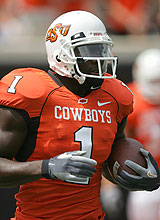Tale of the tape: Bryant vs. Tate
More: Spiller vs. Mathews | Hardesty vs. Mathews | Bradford vs. Clausen | Gresham vs. Gronkowski
The two best receivers in the 2010 draft class have one thing in common: toughness in traffic. There are no alligator arms here – both Dez Bryant and Golden Tate will mix it up inside, jump to catch the ball in traffic and fight for that extra yard. The differences between them, however, make this particular head-to-head interesting.
Whom would you rather have on your team? Let's see what the tape says:
 Bryant Height: 6-2 |  Tate Height: 5-10 |
Pros: Bryant plays with incredible toughness before and after the catch, no matter the circumstance. He handles short routes like a tight end with better speed, is fearless over the middle and doesn't avoid contact with the ball in his hands. Prides himself in the ability to bounce up from hard hits – this is a very tough kid. Adjusts extremely well to badly thrown balls; his body control on the move allows him to bring in catches that other receivers might not. Ran a more complex route tree than most spread offense receivers because then-quarterback Zac Robinson has a better arm than most who throw in that scheme. Has a real knack for sitting in zones and turning quickly to get upfield after the catch. He will frequently break first and even second contact in these situations. Considering his loping stride, he has surprising agility when facing a defender and he'll look to juke his way for extra yardage. Can pick the ball out of virtually any situation, no matter how much traffic he's dealing with – that may be his best attribute. Is on and off as a blocker, though he has the potential to be dominant for his position. Did not work out at the NFL scouting combine due to a hamstring injury. | Pros: Tate benefited extensively from his time in a pro-style offense run by Charlie Weis; there's little doubt that he will go to the NFL as the most polished receiver in this class. With his deep speed and interior quickness, he can run every route from 1-9 and most variations thereof. Makes up for his relative lack of height with a real skill in getting vertical with balls thrown up in traffic. Tate is very cagey when it comes to cutting or rounding off a straight route, and finding space away from tight coverage. His excellent sense of timing allows him to sit in zones before coverage springs on him. Builds up a head of steam very quickly after the catch, and combines that with his toughness to become a dangerous post-catch threat. He has the burst to evade converging tacklers, but is also tremendously strong for his size. He deals with downfield defenders like the former tailback he is; he'll look to break contact more than slipping out of sight. Tate has an amazing ability to spin out of first contact which must drive defensive backs crazy – just when you think you've got hands on him, off he goes. Ran unconfirmed sub-4.4 times at the combine, and that kind of speed shows on the field. |
Cons: Bryant lacks top-end downfield speed and will get crowded by defensive backs on deeper routes. This is especially true on routes that require extended timing and throws with a higher arc. He uses angles and physical play to get and stay open, but there should be questions about how he'll fare consistently against faster NFL defenses with more advanced coverage concepts. Maturity issues abound, and not just from the 10-game suspension he served for lying to the NCAA about his relationship with Deion Sanders. Surprising work ethic concerns for such a rugged player. | Cons: Tate has a definite swagger that could be mistaken for a "diva" attitude, and that might turn some teams off. He's not a great blocker and will frequently round off his routes when he needs to make quick cuts – this was a particularly vexing issue at the combine. Tate played running back and defensive back in high school, so he's still learning the fine points of the receiving trade. |
Conclusion: Bryant lost most of the 2009 season due to the aforementioned suspension, and there are other alleged issues that seem to pop up from time to time. The relatively slow times he ran at his pro day wouldn't be a major issue – after all, he's never been a downfield speed player – but for the fact that Bryant was slipping on the turf because he reportedly forgot his cleats. He is a first-round talent, but as teams do their due diligence and finalize their draft boards, Bryant may drop to the bottom half of the first day. | Conclusion: Tate set several school records for the Golden Domers, and he became more and more productive through his collegiate career. He has a combination of quickness, toughness, and consistency that might make him even better in the pros than he was in college. He can work well outside catching curls and fades, but he's pretty much what you'd see if you looked up "NFL slot receiver" in the dictionary. He will run quick slants and outs, will grasp the option routes as he needs to, and will be a major pain in the butt after the catch. Tate also carried the ball 25 times for 195 yards and two touchdowns in 2009. He could add all sorts of end-around and option plays to his new team's playbook. |
Pro comparison: Michael Crabtree(notes), San Francisco 49ers | Pro comparison: Steve Smith, Carolina Panthers |
Doug Farrar is a regular contributor to Yahoo! Sports' Shutdown Corner
